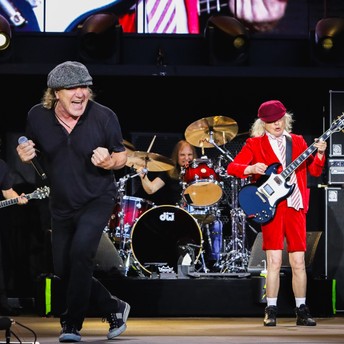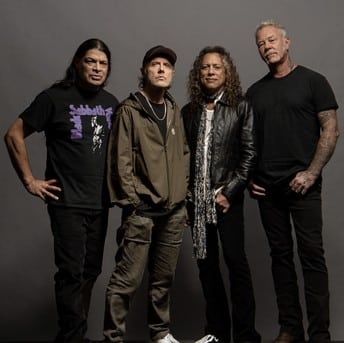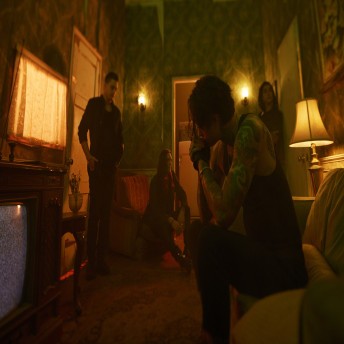Rock
Page: 8
Trending on Billboard
AC/DC will continue their globe-hopping Power Up tour into 2026 with Monday morning’s (Nov. 3) announcement of a run of 21 more shows in South America and North America next year. The new dates for the nearly two-year-old tour by the legendary Australian hard rockers will kick off on Feb. 24 at Estádio do MorumBIS in São Paulo, Brazil and include stops in Santiago, Chile on March 11 and Buenos Aires, Argentina on March 23 before winding down on April 7 in Mexico City at Estadio GNP Seguros.
Explore
See latest videos, charts and news
The band will then take the spring off and be back on the road beginning July 11 in Charlotte, N.C., followed by shows in Columbus, Ohio, Madison, Wi., San Antonio, Denver, Las Vegas, San Francisco, Edmonton, Alberta, Vancouver, Atlanta, Houston, South Bend, Ind., St. Louis, Montreal, Toronto and East Rutherford, N.J. before winding down on Sept. 29 at Lincoln Financial Field in Philadelphia.
Tickets for the upcoming run of 2026 shows will be on sale at 10 a.m. ET on Friday (Nov. 7); click here for details.
The Rock and Roll Hall of Fame act — singer Brian Johnson, guitarist Angus Young, rhythm guitarist Stevie Young, drummer Matt Laug and bassist Chris Chaney — kicked off the tour named for their 17th studio album in May 2024. The band’s next scheduled date is on Nov. 12 at the Melbourne Cricket Ground in Melbourne, Australia.
Check out the 2026 dates for AC/DC’s Power Up tour below.
Feb. 24: São Paulo, BR @ Estádio do MorumBIS
March 11: Santiago, CL @ Parque Estadio Nacional
March 23: Buenos Aires, AR @ Estadio River Plate
Apr. 7: Mexico City, MX @ Estadio GNP Seguros
July 11: Charlotte, N.C. @ Bank of America Stadium
July 15: Columbus, Ohio @ Ohio Stadium
July 19: Madison, Wis. @ Camp Randall Stadium
July 24: San Antonio, Texas @ Alamodome
July 28: Denver, Colo. @ Empower Field at Mile High *
Aug. 1: Las Vegas, Nev. @ Allegiant Stadium *
Aug. 5: San Francisco, Calif. @ Levi’s Stadium
Aug. 9: Edmonton, AB @ Commonwealth Stadium
Aug. 13: Vancouver, BC @ BC Place
Aug. 27: Atlanta, Ga. @ Mercedes-Benz Stadium
Aug. 31: Houston, Texas @ NRG Stadium
Sept. 4: South Bend, Ind. @ Notre Dame Stadium
Sept. 8: St. Louis, Mo. @ The Dome at America’s Center
Sept. 12: Montreal, QC @ Parc Jean-Drapeau
Sept. 16: Toronto, ON @ Rogers Stadium
Sept. 25: East Rutherford, N.J. @ MetLife Stadium
Sept. 29: Philadelphia, PA @ Lincoln Financial Field *
*Denver, Las Vegas, and Philadelphia on sale at 12pm local time
Billboard’s Live Music Summit will be held in Los Angeles on Nov. 3. For tickets and more information, click here.
Trending on Billboard The Cure have announced the release date for The Show of a Lost World concert film, a full-length live performance featuring all the songs from the band’s most recent studio album, 2024’s Songs of a Lost World. The movie will play exclusively in theaters worldwide on Dec. 11 for a limited time, […]
Trending on Billboard
Metallica’s long-awaited M72 World Tour stop in Perth took an unexpected turn over the weekend when two concertgoers were arrested and charged with trespassing after allegedly scaling a central tower inside Optus Stadium during the band’s performance.
Explore
See latest videos, charts and news
According to Western Australia Police, the incident occurred on Saturday (Nov. 1) during Metallica’s first Australian show since 2013. The two men — a 20-year-old from Carey Park and a 23-year-old from Australind — were removed from the venue and will face court for the dangerous stunt.
Police confirmed that a 20-year-old man from Carey Park and a 23-year-old man from Australind were arrested and charged with trespassing after scaling the structure.
“It will be alleged the men climbed up the central tower inside the bowl at the Metallica concert held at Optus Stadium on Saturday,” a WA Police spokesperson said, according to news.com.au.
The concert marked the band’s first return to Australian soil in over a decade. Their last local appearance was headlining the now-defunct Soundwave Festival in 2013, where they shared the bill with blink-182, Linkin Park, Slayer and Paramore.
Support came from Suicidal Tendencies and Evanescence, while fans lined up earlier in the week at a dedicated M72 pop-up shop in Perth, offering exclusive merch, screen-printed posters, vinyl, and tour-themed skateboards.
Metallica has enjoyed remarkable success on the Billboard charts, with their 1991 self-titled album, known as The Black Album, debuting at No. 1 on the Billboard 200 and becoming one of the longest-charting albums in the chart’s history.
The band’s Australian tour continues with upcoming shows in Adelaide (Nov. 5), Melbourne (Nov. 8), Brisbane and Sydney over the next week. After wrapping their Australia and New Zealand shows, the rockers will continue the tour with Bahrain and the United Arab Emirates. Their current M72 World Tour will wrap in July 2026, following dates in Europe and the U.K.
Full tour details are available on the band’s official website.
Trending on Billboard
Taylor Momsen is revisiting a holiday classic — with a rock twist.
The Pretty Reckless frontwoman has re-recorded “Where Are You Christmas?” 25 years after first performing the song as Cindy Lou Who in How the Grinch Stole Christmas.
The reimagined version appears on the band’s new holiday EP, Taylor Momsen’s Pretty Reckless Christmas, released Friday (Oct. 31) via Fearless Records.
Explore
See latest videos, charts and news
The original ballad, co-written by Mariah Carey, James Horner, and Will Jennings, first appeared on the 2000 film’s soundtrack and was famously performed by Momsen at just seven years old. That same year, Faith Hill’s version reached No. 65 on the Billboard Hot 100.
Momsen’s 2025 update opens with a nostalgic snippet of her childhood recording before launching into a full-blown rock version, anchored by crunchy guitars and her signature gritty vocals. “Where are you, Christmas? Why can’t I find you?” she sings, giving the wistful lyrics new energy and edge.
The six-track EP also includes four original songs — “I Wanna Be Your Christmas Tree,” “Christmas Is Killing Me,” “Blues on Christmas,” and “When We Were Young” — as well as a reprise titled “Christmas, Why Can’t I Find You.”
“Pretty Reckless Christmas started as just one song, but the moment we got into the studio, it took on a life of its own,” Momsen said in a statement. “There was so much emotion, nostalgia and chaos wrapped up in it that it didn’t feel right to leave it standing alone. To really honor it, I needed to build a whole world around it. That’s how this project became a full body of work — something bigger, deeper and far more personal than I ever expected.”
Momsen’s last studio album with The Pretty Reckless, Death by Rock and Roll, debuted at No. 1 on Billboard’s Top Album Sales chart in 2021, making them the first female-fronted band to hit No. 1 on the chart with their first four albums.
Meanwhile, “For I Am Death,” The Pretty Reckless’ first new music since its 2021 album Death by Rock and Roll, climbs to No. 1 on the ranking dated Nov. 8. It’s the band’s eighth leader and fourth straight, a streak that dates to 2020, when “Death by Rock and Roll” led for three weeks, followed by reigns for “And So It Went” and “Only Love Can Save Me Now” in 2021.
In 2013, The Pretty Reckless made its maiden appearance on the tally with “Heaven Knows,” a song that ended up reigning for four weeks beginning in March 2014. That kicked off a streak of four consecutive No. 1s, with “Heaven Knows” followed by “Messed Up World” (2014), “Follow Me Down” (2015) and “Take Me Down” (2016).
Billboard rounds up the highlights for one of the most uniquely presented gigs of the Foos’ decades-spanning career.
10/31/2025
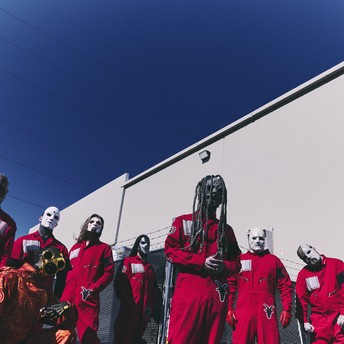
Trending on Billboard
When you think of Sid Wilson, it’s likely you’ll think of the unsettling gas masks he sports on stage as Slipknot‘s DJ. You’ll likely think of Wilson’s disorienting scratch and drum effects, or of his signature mullet and tattoos. You likely won’t think of the Geto Boys and Bushwick Bill.
Explore
See latest videos, charts and news
It’s admittedly hard to picture at first. When Billboard chats with Wilson via Zoom, he sits in his studio wearing a leopard print jacket, a chain-linked necklace and dark-tinted sunglasses in what is essentially the signature starter kit for any successful metal star. He is holding a large Chucky doll with ski goggles placed around its head. It is almost Halloween after all, but Wilson says he brought it to our interview in the spirit of Bushwick Bill — the Geto Boys rapper who passed away from pancreatic cancer in 2019.
“I’m gonna put him back here so he can keep an eye on things,” Wilson says before placing Chucky on his keyboard. “He’s here for quality assurance.”
Wilson started his record label Vomit Face earlier this year, and announced the first big release would be a debut album by Lil Bushwick, who is late rappers son. The album drops on Oct. 31, but a closer look at Vomit Face’s roster shows that it’s actually all rappers at this moment. Wilson notes that this was a very intentional decision, but that the most important thing is that each artist here learns how to become multifaceted.
“We don’t gatekeep here,” Wilson says. “I want you to know the secrets behind the curtain of the Wizard of Oz. Like, when you go to film school, they make you take a class that’s called “respect for acting.” A lot of people don’t wanna take that class cause they wanna be a director! But when they take that class, they understand what’s it like to be in the actor’s shoes when a director is pushing the artist to do the things they need to do… That’s the thing about teaching the secrets of the industry. This way we can work together and be a family.”
Below, Sid Wilson talks about what it’s like being a label head, his relationship with Bushwick Bill, and why he prioritized hip-hop for his new label venture.
How’s being a label head?
Oh, I love it. This time around I was just producing so many different things and different people and quite a few of them were independent, so it was kinda like we’d finish a project and we’d be like, “Ok, who are we gonna shop this to? How many things do we gotta come up with to entice a label?” It was kind of a pain in the butt to sell yourself with someone, especially when you’re an artist who already believes in yourself.
So I just started accumulating all of these projects and didn’t have anywhere to release it, and I just did not wanna deal with these labels having to finagle different things out of them. “We want the artist to keep his masters,” and all this f—king bulls—t you gotta argue about with them about, when they don’t even know the blood, sweat and tears it took to create the stuff. That just seemed unfair to me, for the artist to not have total control of their art.
Like, we [Slipknot] just finished our contract with Roadrunner Records. Seven albums, I’m 48 years old now. We signed that when I was like 20 years old. Over half of my life, and it took that long to get free of it. Like, the amount of money the band could make off of one album could be more than potentially the entire career of the band, and that’s not fair to me.
And the name Vomit Face Records just kinda came to you?
I grew up in Chicago doing a lot of warehouse parties, and out there it was called the “ugly face.” Like when you hear something really good, like a good beat or track. Way before that when I was young they had the “gas face.” In the Bay area they had the “thizz face.” So when I was doing the Lil Bushwick album, the beat just dropped and I was like, “ewwww!” Like that’s the “vomit face,” you know? Like the pinnacle of faces. What’s the craziest of the faces when the beat drops? The vomit face, its so gnarly it gives you face paralysis. Everything from then on just kinda maintained that format.
Your debut roster here is mostly rappers, which considering your background with Slipknot feels surprising. How intentional was that?
Yeah, Vomit Face was more directed to hip-hop but with a punk rock edge. There’s a couple hip-hop groups on the label but bands are a very in depth process. I still produce bands, but generally I’ll shop them out to another label. There’s a lot of logistics involved. With a group you have more than one persons life happening. There’s a lot of logistics involved outside the group. How many people are in the group, how many of those people have families, how many of those people have kids, how many of those people are living in the same city together or spread out? What’s their capability of being able to practice together on a daily basis?
There’s a psychological side to it where you have to get to know them on a more personal level, and talk to them about more than just music. Dealing in hip-hop, there’s a lot less logistics, even if it’s a hip-hop group. Traditionally they won’t have a drummer, a guitarist, a DJ. There’s not a whole surroundings of each person’s instruments and what it takes to capture those instruments.
I’m not saying hip-hop is easier, there’s just a lot less logistics to focus on so you can really grind a lot harder with the individual and spend more time with the individual than with a band.
Do you find the psychological aspect easier to manage with rappers?
I don’t know if it’s easier. Maybe that’s a whole other thing to. The work flow from hip-hop can be vastly different from artist to artist. You’ll hear music that comes out that’ll be like, “Oh, this was recorded seven years ago,” or, “We just did this last night!”
You just never know what you’re getting into and you’re talking to a lot of people who come from street life too so you’re not gonna know what’s going on in their lives, or where they’re at, or what their availability is going to be. Some people just drop off the face of the earth for a minute, and don’t get back until later. Some of them because of the street aspect are very hungry, and are kicking your door down every day. It’s vastly different from artist to artist, but then having less logistics to deal with makes it easier to get it done.
What was your relationship to The Geto Boys and Bushwick Bill, specifically?
Obviously, the Geto Boys are iconic, and I met Bill through my buddy’s skate shop “Brooklyn Projects” here in L.A. The owner’s from New York, and a lot of different artists and entertainers will come through this place just because of the skate culture. So I met him through that shop and we decided, “Yo, let’s make some music! Like Bushwick Bill and Slipknot? C’mon!” Logistically, we just couldn’t get it locked down — and we both being entertainers were just traveling a lot and unfortunately not knowing he was ill, I don’t think anybody really knew, so when he passed away it was like, “What?”
That was a hard lesson for me. I would have moved some mountains around if I had known, and it’s terrible to say that because that shouldn’t be the reason to get work done with someone you click with. I felt really bad about that.
What was your last interaction like with him?
It was at the shop, actually. I had an Irish wolf hound named Fred and he was dying of cancer. He had [three kinds] of cancer and we were fighting it with him. He’d get better from one then another would pop up. He was an amazing dog, and I was going through that with him the last time I saw Bill — and he wanted to come track some stuff, and without explaining what was going on in my life, I was like, “I really can’t today.” I was just trying to get back to my dog, but not realizing Bill himself was… you know.
I should have just been like, “C’mon over man, my dog is sick but it’ll be cool.” We might have had a moment together there, something really special. There would have been a whole magical thing there and we all missed out on it. Then meeting his son and finding out he was an artist and doing music and coming to Slipknot concerts, we just hit it off. I made a promise to Bill’s spirit: “I’m gonna do this with your son and I’m not gonna flop. I’m gonna make sure I get it done.” That was that, flew him out to Wilson Estate in Iowa and recorded the album.
What was your relationship like with Lil Bushwick?
I wanted to be there for him. So when I flew him out, we recorded but we went to do things he would have done with his pops. We went fishing — he had never been fishing before! We got to know each other, on a level beyond artists and doing music. We’re family now, and I’d like to be able to be there for him in that respect.
What was it like fishing with him and bonding with him outside of music?
It was awesome, man! I could hear Bill going: “Hey man, that’s cool. Thanks for doing things like that.” We could have just been at the studio recording but I was like, “Hey, let’s go to the pond and catch some fish. Let’s go ride the four wheelers around.” I’m in no way trying to replace his father but to be able to do things with him it was cool. I can be an uncle!
You can hear Bill [in his music]. He’s like a youthful version of him — that was cool to see, how it gets passed down. His dad was really smart too, man, he had a lot of knowledge on a lot of things, and you can see that passed down to Lil Bushwick. He’s very locked-in spiritually.
Amazing, man — it must feel really good to finally have Vomit Face rockin’ and rollin?
It does, man. I got a great team, a great roster. I look forward to bringing people to this roster. I’ve already gotten a million messages from people wanting to be involved. This is a label for the artist by the artist. Own your own music, own your own stuff. Grow with us!
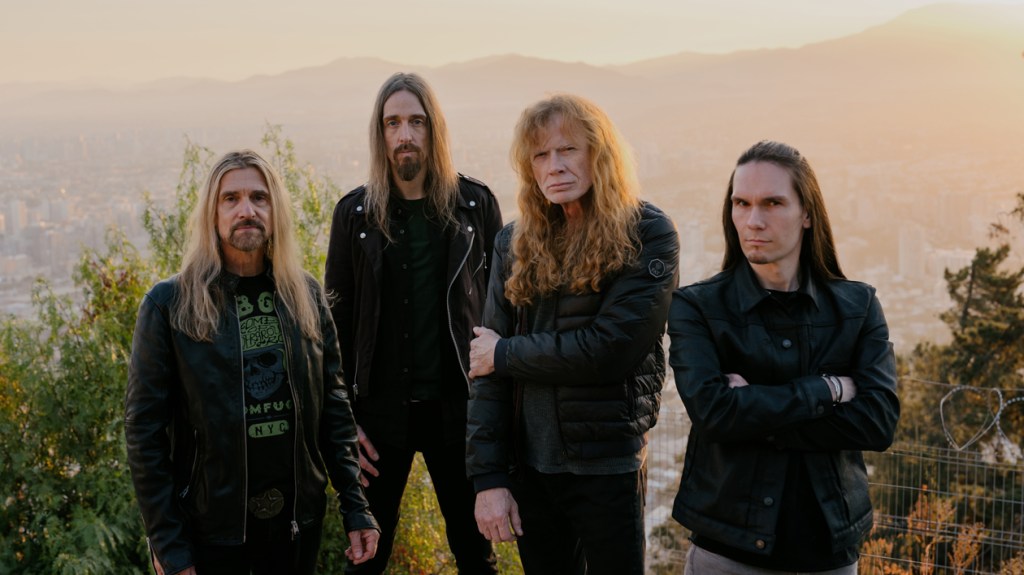
Trending on Billboard
Megadeth has revealed the tracklist for its upcoming final album, and it’ll include a long-awaited bonus track.
The band revealed its self-titled album, due out Jan. 23, will have 10 tracks and will include an 11th bonus song called “Ride the Lightning.” The song was cowritten with Metallica’s James Hetfield, Cliff Burton, and Lars Ulrich, which Megadeth’s frontman Dave Mustaine explained was included on the album to celebrate his career.
“As I come full circle on the career of a lifetime, the decision to include ‘Ride the Lightning’, a song I cowrote with James, Lars and Cliff, was to pay my respects to where my career first started,” Mustaine said in a statement.
Megadeth announced in August the band would be saying farewell after 16 albums. Mustaine confirmed their next project would be the group’s last, sharing a video to the band’s YouTube and social media pages that included Mustaine’s alter ego, Vic Rattlehead, delivering the news.
“For over four decades, I’ve been chained in silence, but the end demands my voice,” Vic begins while seated behind a desk. “It is confirmed: The next Megadeth studio album will be the last. Forty years of metal, forged in steel, ending in fire. And when the new year rises, the global farewell tour. You’ve heard the warning. Now prepare yourself, Cyber Army. Stay loud, stay tuned, and meet me on the frontlines.”
Mustaine then thanked fans in a press release for their commitment and celebrating the band’s impact on rock. “There’s so many musicians that have come to the end of their career, whether accidental or intentional,” he said at the time. “Most of them don’t get to go out on their own terms on top, and that’s where I’m at in my life right now. I have traveled the world and have made millions upon millions of fans and the hardest part of all of this is saying goodbye to them.”
The band will additionally join Iron Maiden on its Run for Your Lives Tour next year.
Check out the tracklist below.
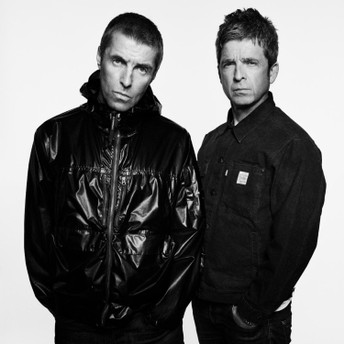
Trending on Billboard
If you attended one of the Oasis ’25 reunion shows this summer you will likely never forget the soul-stirring echo of 50,000+ fans shouting out the lyrics to “Wonderwall” along with singer Liam Gallagher as if the tune was the Oasis National Anthem.
Explore
See latest videos, charts and news
Which it basically is.
That explains why on Thursday (Oct. 30) Oasis announced that they are marking the 30th anniversary of one of their most indelible hits, which has racked up more than three billion streams to date. The band’s biggest hit and an unmovable staple of their live shows will be celebrated with a limited-edition (What’s the Story) Morning Glory? 7″ singles box set due out on Dec. 12, a replica of a highly collectible 1996 cigarette-style CD box set.
The new box includes four 7″ singles — the 2014 remastered versions of “Wonderwall,” “Some Might Say,” “Roll With It” and “Don’t Look Back in Anger” — along with their original b-sides, respectively, “Round Are Way,” “Talk Tonight,” “It’s Better People” and “Step Out.”
In addition to playing around the world on a reunion tour that nobody ever thought would happen, Oasis have spent the year looking back at some of their musical highlights. Last month, they released the 25th anniversary reissue of their Wembley Stadium live album, Familiar to Millions and the 25th anniversary reissue of their fourth album, Standing on the Shoulder of Giants, as well as an unplugged version of “Morning Glory.” To celebrate the launch of their first run of shows in 16 years in July, the group also issued a box set collecting all their studio albums.
This month they also announced a massive book chronicling the tour, Oasis Live ’25 OPUS.
Oasis will march on Friday night (Oct. 31) with the first of three shows at Marvel Stadium in Melbourne, Australia, followed by two gigs in Sydney next weekend and a final run of shows in Argentina, Chile and Brazil to round out the month.
Though a Nov. 23 show at MorumBIS in São Paulo, Brazil is currently the final scheduled date, earlier this month Liam Gallagher answered a fan’s complaint about one of his favorite songs not make the set list by offering up a cryptic tease about future dates. “Chill Winston it’s not even HALF TIME yet it’s a tour of 2 half’s,” Gallagher wrote. To date, spokespeople for the band have not returned Billboard‘s request for comment on potential 2026 tour dates.
Billboard’s Live Music Summit will be held in Los Angeles on Nov. 3. For tickets and more information, click here.
Trending on Billboard
Bad Omens are hitting the road early next year for a North American headlining tour with support from Beartooth and President. The hard-rocking Virginia band announced the dates for the arena swing on Tuesday morning (Oct. 28), with the outing slated to kick off on Feb. 22 at the Delta Center in Salt Lake City, Utah.
Explore
See latest videos, charts and news
Tickets for the tour from the “Specter” band will kick off with an artist pre-sale beginning today at 12 p.m. local time, with additional pre-sales running throughout the week ahead of a general on-sale beginning on Friday (Oct. 31) at 10 a.m. local time.
Earlier this month, the Noah Sebastian-fronted band made their quickest trip to No. 1 on Billboard’s Mainstream Rock Airplay chart, with “Specter” hitting the top on the Oct. 18-dated chart after rising two spots, landing the group their second leader on the tally. “Specter” reached the pinnacle in its eighth week, easily leap-frogging the 27 weeks it took their previous No. 1, “Just Pretend,” to hit the top in 2023.
Bad Omens’ most recent proper studio album was 2022’s The Death of Peace of Mind, which was followed by 2024’s guest-heavy companion to the Bad Omens — Concrete Jungle, Volume 1 graphic novel, Concrete Jungle.
The 20-date 2026 arena tour will hit Denver, Kansas City, Detroit, Minneapolis, Toronto, Boston, Philadelphia, Nashville, Dallas, Oklahoma City and Los Angeles before winding down on March 27 at Oakland Arena in Oakland, Calif. The band will then gear up for the North American tour by kicking off their Do You Feel Love European swing on Nov. 21 in Dublin, Ireland.
Check out the dates for Bad Omens’ 2026 North American arena tour below.
Feb. 22: Salt Lake City, Utah @ Delta Center
Feb. 24: Denver, Colo. @ Ball Arena
Feb. 26: Kansas City, Mo. @ T-Mobile Center
Feb. 28: Detroit, Mich. @ Little Caesars Arena
March 2: Minneapolis, Minn. @ Target Center
March 4: Rosemont, Ill. @ Allstate Arena
March 6: Toronto, ON @ Scotiabank Arena
March 8: Laval, QC @ Place Bell
March 10: Newark, N.J. @ Prudential Center
March 11: Boston, Mass. @ TD Garden
March 13: Philadelphia, Pa. @ Xfinity Mobile Arena
March 14: Baltimore, Md. @ CFG Bank Arena
March 16: Raleigh, N.C. @ Lenovo Center
March 17: Nashville, Tenn. @ Bridgestone Arena
March 19: Dallas, Texas @ American Airlines Center
March 20: San Antonio, Texas @ Frost Bank Center
March 22: Oklahoma City, Okla. @ Paycom Center
March 24: Glendale, Ariz. @ Desert Diamond Arena
March 26: Inglewood, Calif. @ Kia Forum
March 27: Oakland, Calif. @ Oakland Arena
Billboard’s Live Music Summit will be held in Los Angeles on Nov. 3. For tickets and more information, click here.
Trending on Billboard
“As you might know, this is the first night of the tour,” Tame Impala’s Kevin Parker told a buzzing, sold-out crowd at Brooklyn’s Barclays Center on Monday night. “That means it’s a pretty epic night, and there was nowhere more epic to kick this whole shit off than New York City, obviously.
“That [also] means anything can happen,” the Aussie psych-rocker-turned-arena-star continued. “And by that, I mean for the better, but also anything can fall apart at any moment – just so you know.”
Improbably, Tame Impala has become one of modern rock’s biggest live draws. But its catalog is littered with insecurity and loneliness – from 2010 breakout single “Solitude Is Bliss” to beloved 2012 album Lonerism to “Loser,” now a Hot 100 hit from the just-released new album Deadbeat – and even after headlining festivals, producing a Dua Lipa album, and winning a Grammy, Tame mastermind Kevin Parker still clearly has some imposter syndrome.
Five albums in, Tame Impala now has a large enough catalog that tough setlist choices must be made; always known for lasers and confetti, its stage production is more complex than ever, with far more audio and visual components to possibly malfunction. And prior to Barclays on Monday, Tame Impala hadn’t played a proper headlining show in two-and-a-half years.
But Parker – outside of a mildly worn voice he attributed during the encore to an unspecified ailment – had little to worry about. Critics haven’t embraced Deadbeat in the same way as the band’s past projects, but fans greeted freshly minted hits “Dracula” and “Loser” nearly as rapturously as Tame standards like “Let It Happen” and “The Less I Know The Better.” The excitement extended to other Deadbeat material (the setlist featured 10 of its 12 tracks), which the audience responded to even more than cuts from Tame’s first two acclaimed albums, Innerspeaker and Lonerism. The band’s stage production, meanwhile, was more elaborate than ever, while still channeling the colorful, psychedelic aesthetic that’s always been its calling card.
“The only one who’s really judging you is yourself – nobody else,” Parker sings on Innerspeaker deep cut “Alter Ego,” an unexpected inclusion on Monday’s setlist. As the dance-oriented Deadbeat‘s mixed reception has proven, that’s no longer quite true, at least for Parker. But the Barclays crowd on Monday was clearly in his thrall – as those at the next three shows Tame Impala has planned at the venue this week will also surely be.
Here are some of the best moments from Tame Impala’s first Deadbeat show – and when you’re done with that, here’s the complete setlist.
Billboard‘s Live Music Summit will be held in Los Angeles on Nov. 3. For tickets and more information, click here.
A Different Crowd

 State Champ Radio
State Champ Radio 